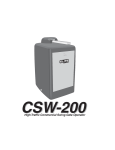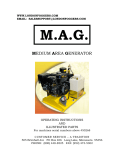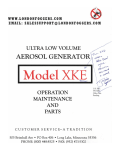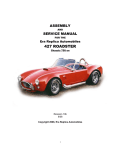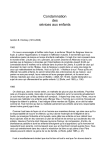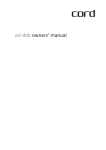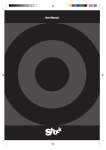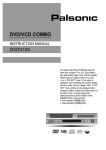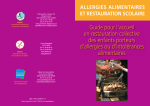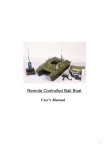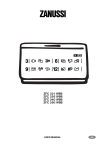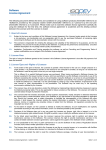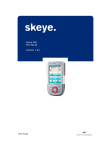Download Model XKE - London Foggers
Transcript
Rev. 01/2013 WWW.LONDONFOGGERS.COM EMAIL: [email protected] Model XKE LARGE AREA ULV GENERATOR OPERATING INSTRUCTIONS AND ILLUSTRATED PARTS For machines serial numbers above #1950 505 Brimhall Ave PO Box 406 Long Lake, Minnesota 55356 PHONE: (800) 448-8525 FAX: (952) 473-5302 1 INDEX Forward 1 Specifications 5 Safety Precautions 6 Assembly / Installation 8 Service Before Start – UP 9 Pre Start Check List 10 Start – Up 11 Operation 11 Setting Flow Rate 12 Calibration 12 Spraying 13 Flushing 14 Service Schedule 16 Maintenance 2 Air Pressure 17 Air Pump 19 Belts 20 Engine Oil 21 Nozzle 39,18 Flushing 21 Air Pump Oil 22 Formulation Filter 24 Engine Air Cleaner 25 Battery 25 INDEX (continued) Maintenance (continued) Pulsation Damper High Pressure Switch 3 28 (NA) Trouble shooting 30 Preparation for storage / winterization 33 Schematic Fluid System 34 Wiring Diagram, Machine 35 Machine Exploded View 35,36,37 Illustrated Parts 38,39 Warranty 40 FORWARD The application of insecticides is the predominant methods by which we can limit the size of insect populations. Due to economic as well as environmental reasons, it is desirable to treat a given area with the least amount of insecticide that can be made to be effective. The most efficient method is to break up 1-2 ounces of liquid into aerosols and distribute these fine droplets over the affected acre of land. The fine particles stay suspended for longer periods of time due to their size and are distributed more evenly, remaining effective longer. The term U.L.V. is an abbreviation for the terms Ultra Low Volume. Ultra Low Volume is the designation of the technique of treating areas with relatively small amounts of chemicals in the aerosol state. These chemicals are usually in a more concentrated state than chemicals used in other methods of application. For best results, London Fog ULV Aerosol Generator should be operated and maintained in compliance with formulation label instructions. DESCRIPTION This machine is intended to be vehicle or trailer mounted and is designed to be operated by the driver of the vehicle with the in cab remote control box. 4 SPECIFICATIONS 5 TYPE: Vehicle or trailer mountable – Non- Thermal, U.L.V. (Ultra Low Volume) cold fog aerosol generator. ENGINE: Kohler, Command, one cylinder, 4 – cycle, gasoline, 8.5 HP, 12 Volt, Fuel Consumption – regular or no lead automotive – 0.5 gal / hr. electric start with alternator. AIR PUMP: Positive displacement, 4 cylinders, all cast iron, belt driven, 900 R.P.M. FORMULATION PUMP: Positive displacement piston pump with adjustable output from 0 to 18 oz / min. (0 to 295.7 ml / min.) NOZZLE SYSTEM: 360° horizontal adjustment (azimuth) and 30 ° - 60° vertical adjustment (elevation) TANKS: All tanks corrosion – resistant, high density polyethylene (formulation and flushing tanks only). Formulation: 15 U.S. Gallons (56.7 Liters) Flushing Optional: 1.5 U.S. Gallons (5.67 Liters) (Optional) Gasoline: 3.0 U.S. Gallons (11.3 Liters) PARTICLE SIZE: 5 to 20 Microns MMD (Mass Median Diameter) depending on flow rate and viscosity. WEIGHT EMPTY: 280 Pounds (127 Kilograms) LENGTH: 38 Inches (106 cm) WIDTH: 33 Inches (86 cm) HEIGHT: 31 inches (76 cm) SAFETY PRECAUTIONS WARNING READ AND UNDERSTAND THESE SAFETY PRECAUTIONS BEFORE OPERATING MACHINE. 1. ENGINE AND FUEL: This machine uses gasoline as the fuel for the internal combustion engine and all precautions commonly applying to this volatile fuel should be observed. Exercise extreme caution to avoid spilling of gasoline. If spillage occurs, wipe it off and allow evaporation time before starting the engine. DO NOT attempt to put fuel in the tank while the machine is still running. Avoid smoking or open flames in area when handling gasoline. Never run the unit indoors unless exhaust is vented outside. These fumes contain carbon monoxide which is colorless and odorless and can be fatal. NOTE DO NOT OPERATE ENGINE WITHOUT MUFFLER DO NOT TOUCH HOT MUFFLER, CYLINDERS OR FINS AS CONTACT MAY CAUSE BURNS Except for adjustment, DO NOT OPERATE THE ENGINE IF AIR CLEANER OR COVER DIRECTLY OVER THE CARBUETOR AIR INTAKE IS REMOVED. DO NOT RUN THE UNIT IF THE BELT GUARD IS REMOVED. DO NOT TAMPER WITH THE GOVERNOR SPRINGS, GOVERNOR LINKS OR OTHER PARTS WHICH MAY INCREASE OR DECREASE THE GOVERNED ENGINE SPEED. 2. ENGINE SPEED (RPM) should be checking periodically to ensure that it is operating correctly, as the engine affects the air pressure and formulation flow which affects droplet size. The correct engine speed should be 2700 RPM plus or minus 150 RPM. 3. MACHINE DAMAGE: Never operate a machine after it has been damaged. A damaged machine can be very hazardous. 4. WIND: Spraying during windy conditions is not usually practical because the formulation will drift out of the intended area. However, under NO circumstances should spraying into the wind be attempted. This may cause hazardous accumulations of formulation on the machine or carrying vehicle. 6 Safety Precautions (Continued) 5. SAFETY EQUIPMENT: In addition to any safety equipment that may be required by the type of formulation which is being used, the following items should be with each vehicle which carries this machine during fogging operations: a. b. c. d. e. f. g. Fire Extinguisher, Chemical type rated for fuel fires. First Aid Kit. Eye Wash solution. Safety Glasses. Container of Oil Dry Compound. Gloves rated for high temperature. Respirator adequate for formulation being used. 6. CHILDREN: Many spraying operations are preformed in residential areas commonly at dusk. This presents the operator with the problem of children who are attracted to the noise and/or the mist being created. The Possible hazard lies in the toxic effect of some formulations, the severity of which depends upon the chemical used, mist density, and the length of time of direct exposure. IT IS THE OPERATOR’S RESPONSIBILITY TO DISCOURAGE ANY ONE FROM PLAYING IN THE MIST OR BEING NEAR THE MOVING VEHICLE. 7. FORMULATIONS: Ensure that formulations are applied only in strict compliance with the formulation label as well as local, state, and federal regulations and that these formulations are dispersed only by trained personnel of public health organizations, mosquito abatement districts, pest control operators or other qualified personnel. a. Always comply with any requirements for protective clothing, goggles, gloves, facial masks, or respirators required on formulation label. b. Do not exceed the dosage set fourth on the registration label of the insecticide to be used. c. Always store formulation in its original labeled container. IN NO WAY IS IT TO BE CONSTRUED THAT THE CHEMICAL AND/OR DOSAGES ARE THE RECOMMENDATION OF LONDON FOG, INC. LONDON FOG, INC SHALL IN NO EVENT BE LIABLE FOR CONSEQUENTIAL DAMAGE OR CONTINGENT LIABILITIES ARISING OUT OF THE FAILURE OF ANY AEROSOL GENERATOR OR PART TO OPERATE PROPERLY. 7 II. ASSEMBLY/ INSTALLATION INSTRUCTIONS 1. Uncrate the unit and remove all packing materials. NOTE It is a good idea to retain the original machine shipping carton as well as its inner packing and blocking material for any future storage and/ or shipment which may be required. 2. Place the Remote Control Unit where it will not be damaged while machine is being prepared. 3. Lift the machine onto the vehicle with the discharge end of the machine towards the rear of the vehicle. 4. If permanent vehicle installation is desired, the remote control cable can be passed through a small hole in the vehicle cab and then reconnected. Make sure the small hole provides proper protection against wiring damage and is re-sealed to prevent exhaust gases from entering inside of the vehicle. 5. Using the most convenient routing, run control harness to the connecting support bracket located on the engine gas tank bracket. Orient the electrical plug on the harness so that the electrical pin location match the mating pin receptacles in the socket and push the plug firmly into the socket. 6. Securely bolt the machine to the vehicle. 7. Correct battery type is any GM 12V car battery with the most cold cranking AMPS as possible. Please do not use a lawn mower/tractor battery. WARNING DANGER POISON BATTERIES PRODUCE EXPLOSIVE GASES. KEEP SPARKS, FLAME, CIGARETTES, AWAY. VENTILATE WHEN CHARGING OR USING IN AN ENCLOSED SPACE. BATTERIES CONTAIN SULFURIC ACID WHICH CAUSES SEVERE BURNS. IF ACID CONTACTS EYES, SKIN, OR CLOTHING FLUSH WELL WITH WATER. FOR CONTACT WITH EYES GET IMMEDIATE MEDICAL ATTENTION. KEEP BATTERY AND ACID AWAY FROM PERSONS WHO MAY NOT BE AWARE OF DANGERS INVOLVED. 8 ASSEMBLY / INSTALLATION INSTRUCTIONS (continued) A. Remove battery from its mounting and place on a stable workbench. B. Charge12 volt battery at 30 – 40 amps until the acid temperature is above 80 degrees F. ( 26 degrees C. ) and the hydrometer reading is 1.250 or higher. C. Connect Positive ( + ) cable (leading from the starter switch which is located on the engine switch panel) to the positive ( + ) post on the battery and tighten bolt. D. Connect the negative ( - ) cable to the negative ( - ) post on the battery and tighten bolt. a. When installing battery, connect the negative ( - ) cable last to prevent sparking and shorting. b. When disconnecting is required, remove negative ( - ) connection first. c. Reversed polarity can cause damage to the starting and charging systems. NOTE After battery has been initially services, only water should be added to restore the liquid level in each cell. Further addition of acid will cause battery failure. 8. Loosen the ball swivel joint and orient the nozzle as required by the formulation label. Usual set-up is towards the rear and 45o up. Retighten the ball joint. III. SERVICE BEFORE START-UP 1. Engine: Service engine with gasoline and oil as per the accompanying Engine Operating and Maintenance Instructions. (Engine may come serviced with oil from factory) 2. Air Pump/Compressor: Before starting the machine, remove the dipstick and check oil level. Fill as necessary with synthetic compressor oil such as Anderol 500 or Amsoil Synthetic Reciprocating Compressor non-detergent type oil for the first 50 hours of operation. Oil level should never be higher than the upper mark on the dipstick, nor lower than the lower mark. After the 50 hour break in period, the compressor oil should be changed to a synthetic oil such as Anderol 500 or Amsoil Synthetic Reciprocating Compressor oil available locally or from London Fog, Inc. (part number 6-205) 9 NOTE The synthetic type oil is recommended due to the lower maintenance requirements for the air pump and other components. DO NOT mix oils. 3. Drive Belts: Check drive belts which should be in perfect alignment and tight. IV. PRE-START CHECKLIST 1. Verify that the remote control is within easy reach of the operator. 2. Verify that the nozzle is in the correct position as required for the spraying operation to be accomplished, and that the ball joint which allows this positioning is tight. 3. Verify that the air pump has sufficient fuel and is properly lubricated. 4. Verify that the air pump has been serviced. 5. Inspect all hoses for abnormal conditions. 6. Verify that no foreign objects or tools have been left in or about the machine. 7. Verify that sufficient amount of formulation is in the tank and that the tank filling plug is tight, and that the air vent hole (located on the underside of the tank handle) is not obstructed. 8. Verify that the battery is mounted securely and cable connections are proper and tight. 9. Verify that all safety equipment is in place and is in proper working order. CAUTION 10 Before proceeding with any spraying operation, the operator should be thoroughly familiar with starting and stopping the machine and with all the operating controls. If you are operating the machine for the first time, exercise the machine through its full operational sequences from a position of full visibility of the machine before operating the machine fully remote. This is also a good idea for experienced operators who may be operating a new machine or who may be reactivating a machine after repairs or a period of inactivity. Refer to the operation section for starting and stopping instructions. START UP NOTE On machines equipped with remote start, the engine maybe started from either the engine or the remote control box. When cold, choking may be required on the initial start-up. 1. Verify that the spray On-Off switch on the remote control box is in the OFF position. 2. Place the Ignition On-Off switch on the remote control box into the ON position and the ignition key on the engine to the “ON” position. 3. The engine may now be started from either the remote control box with the START switch of from the engine by turning the key to the START POSITION. NOTE The best starter life is provided by using short cranking cycles of several seconds: prolonged cranking can damage the starter motor if cranked more than 15 seconds per minute. CAUTION On each start up, be sure the formulation pump does not run dry. If there is no formulation in the lines, immediately turn on the spray nozzle so that formulation is drawn through the system. The spray must be turned off as soon as formulation reached the nozzle. 11 VI. OPERATION Read this complete OPERATION section and the section on SAFETY PRECAUTIONS before starting the machine. For first time operation the sections on INSTALLATION, SERCIVE BEFORE STARTUP, and PRESTART CHECKLIST must be performed before proceeding with operation. When operating this machine for the first time, move to an uncongested and well ventilated work area in an open area away from flammable materials. WARNING READ THIS SECTION ON SAFETY PRECAUTIONS BEFORE PREPARING TO DISPENSE FORMULATION. READ AND THOROUGHLY UNDERSTAND ALL INFORMATION, CAUTIONS AND WARNINGS ON THE FORMULATION LABEL WHICH MAY AFFECT PERSONAL SAFETY. KNOW ANY DANGERS OF THE SOLUTION USED AND KNOW WHAT TO DO IN CASE OF AN ACCIDENT INVOLVING THE SOLUTION. ALWAYS USE THE APPROPRIATE SAFETY EQUIPMENT AND DRESS ACCORDING TO THE CHEMICAL FORMULATION WHICH IS BEING USED. DO NOT USE ANY SUBSTANCES FROM UNMARKED CONTAINERS OR FROM CONTAINERS WITH OBVIOUSLY ALTERED LABELS. READ AND FOLLOW THE INSTRUCTIONS ON THE CHEMICAL SOLUTION LABEL FOR ULV SPRAYING OF THE SOLUTION. DO NOT SPRAY NEAR AN OPEN FLAME OR HOT MATERIALS. DO NOT LEAVE THE MACHINE UNATTENDED. 1. CALIBRATION: SETTING THE FLOW RATE CAUTION Before calibration, be sure the machine fluid lines are free from any air bubbles. On initial start-up, it may be helpful to temporarily move the pump pointer to a high scale reading to get the system primed and the lines purged of any air bubbles. 12 OPERATION (continued) 2. SPRAYING CAUTION Before dispensing insecticide, be certain that no one is present in the area of the nozzle or aerosol dispersion area. A. To dispense insecticide with the ULV machine running, move the flow control on / off nozzle switch (cab control) to the ON position. The green indicator light should come on. B. The air pressure gauge on the cab control panel should read between 75 and 85 pound per square inch pressure. If this pressure is not present, shut off the flow control switch and see Air Pressure Instructions. DO NOT dispense insecticide until the air pressure problem is corrected. 13 OPERATION (continued) The fluid pump system is calibrated to the graduated scale on the pump at the London Fog factory. If any major deviation in the flow rate occurs, first check the other components in the system (such as strainers, fittings, etc.). Check for air bubbles in the suction side of the lines as well as the pressure side. Check for fluid leaks in the pressure side of the lines. Minor deviations not created by equipment malfunctions (should they occur) may be recalibrated by measuring the flow and adjusting the pump metering pointer until the desired flow is obtained. To measure the flow, disconnect the fluid line from the aerosol nozzle. Place the disconnected line into an empty container. Start the pump. With the cab panel flow control switch turned on, fluid will be pumped through the disconnected line into the container. Move the disconnected line from the container to a measuring beaker for a measured amount of time – preferably using a stop watch. Compare the measured amount to the flow desired or to the pump scale. Adjust or lock the pump pointer as may be required. Be sure to replace all lines and fittings after calibrating. The following are trough estimates of flow rates using very light mineral oil. Always calibrate to establish correct flow rates for the chemical or insecticide to be used. Flow Rate (ml/minute) 95 150 250 320 410 475 14 Flow Rate (oz./minute) 3 5 8.40 10 14.20 16 Pump Scale Setting .50 1.00 1.50 2.00 2.50 3.00 OPERATION (continued) FINISHED OPERATION: When the spraying operation is complete, the unit must be flushed in accordance with “FLUSHING SYSTEM” section of this manual. 4. FLUSHING A. Before Storage: When flushing for storage, drain the formulation tank and place flushing fluid in the main formulation tank. Run the generator with the nozzle solenoid valve in both the ON and OFF positions to clean all lines. Drain any remaining flushing solution from the formulation tank. Repeat as necessary. B. After each use (without Built-In Flusher accessory): 1. With the aerosol generator running, turn ON the spray nozzle. 2. At the formulation filter (large white nylon assembly), disconnect the larger (3/8”) fluid line which runs from the filter to the PosiDrive pump. Place this line in a container of flushing solution. Run the unit until the flushing fluid has cleaned the lines, pump and nozzle. NOTE More rapid flushing may be accomplished by moving the pump pointer to a high flow rate setting. CAUTION When flushing the generator, the spray switch MUST be turned ON (at the cab control) so that the machine is discharging aerosol. 3. C. Reconnect the fluid line to the formulation filter. Tighten very finger tight. Do not use wrenches. After each use (with Built-In Flusher): Use same method as B. above except in step #2, just turn the flush valve to the FLUSH position. Eliminate step # 3 above. 15 VII. SERVICE SCHEDULE ITEM TO BE SERVICED Nozzle Air Pressure Calibration Check Air Pump Oil Check Air Pump Belts Check Engine Oil Clean Nozzle Flush Change Air Pump Oil Change Engine Oil Clean Formulation Filter Clean Air Pump Filters Replace Engine Air Cleaner Element Check Battery Check / Gap Spark Plug Decarbonize Engine Service Breaker Points Clean Engine Cooling Fins Check / Set Engine Timing Check Valve Clearances Check All Fittings Check Posi-Drive Pump Belt Check Engine Flywheel Screen Check Engine Crankcase Breather Check / Set Governor Drain Air Pump Pulsation Chamber Check Pulsation Damper Over-Pressure Cut-Off Switch 16 DAILY INTERVAL (HOURS) 25 50 100 500 X X X X X X X X X X X X X X X X X X X X X X X X X X A/R VIII. MAINTENANCE 1. AIR PRESSURES A. Low Air Pressure 1. Air pressure to air tip 75 – 85 psi, as measured by air pressure gauge on machine gauge panel. 2. Engine should run at 2700 rpm and air pump at 925 rpm. A loose or slipping belt can cause loss of air pump rpm. Malfunctioning engine or governor out of adjustment can cause improper engine rpm. 3. Air leaks can cause reduced pressure even though engine and air pump are operating OK. Air leak at or around air-fluid nozzle tip or junction with the nozzle body can cause reduced pressure. Be sure that Teflon gasket (part # 6-306), which seals the mating surfaces between the air fluid nozzle and nozzle body, is in good condition and properly installed. Be sure that air fluid nozzle is properly tensioned against the Teflon gasket. Air leaks at any of the air line joints can also cause reduced pressure. Low pressure as indicated at remote control panel can cause poor atomization resulting in too large fluid droplets. NOTE If nozzle air pressure is below normal on Daily Check-up, check for air leaks at all joints. Air leaks can be detected by holding the hand or fingers close to the various joints and feeling if air under pressure is blown against the hand or fingers. Low nozzle air pressure may also be caused by failure to close the pulsation chamber drain valve after use for draining. B. High Air Pressure If air pressure exceeds normal setting and the engine rpm has not increased above normal, a partial blockage may have occurred in the air cap of the aerosol nozzle assembly. To clean air cap (and fluid nozzle when necessary) use acetone as a solvent for gum or varnish and wipe all surfaces clean with a rag. Carefully clean the orifices in the air cap with toothpicks and acetone. Blow through these orifices with compressed air if available. While air cap is removed, wipe clean all exposed surfaces of the fluid nozzle. 17 MAINTENANCE (continued) Be sure that any deposit or build-up is wiped clean from the projecting snout of the fluid nozzle, where it projects through the center orifice of the air cap. While air cap is removed, also inspect the three holes in the fluid nozzle for deposits or internal build-up. Cleaning of these holes (and removal of the fluid nozzle) is seldom required due to the large area in relation to the air flow area through the air cap. To clean the holes in the fluid nozzle, remove nozzle and clean the three holes with a toothpick and acetone. Also clean all exposed surfaces with a rag and acetone. At the same time, clean the circular air groove in the back of the fluid nozzle. Blow through the three holes with compressed air, it available. All nozzle assembly parts should be soaked in acetone if necessary to soften gum, varnish or other deposits. Use care not to over-tighten the fluid nozzle against its Teflon gasket so as to avoid extruding or damaging this gasket. Replace Teflon gasket if worn or damaged in any way. Unduly high pressure can be caused by air pump turning in excess of 900 rpm, which is unlikely. 18 MAINTENANCE (continued) 2. AIR PUMP Check oil level daily. Oil level must never be higher than the upper mark on the dip rod or lower than the lower mark. Use Amsoil Synthetic Reciprocating Compressor Oil, Anderoil 500 Synthetic Reciprocating Compressor Lubricant or SAE 30 non0detergent petroleum based oil. NOTE The synthetic type oil is recommended due to the lower maintenance requirements for the air pump and other components. 19 MAINTENANCE (continued) 3. BELTS Check drive belts which should be in perfect alignment and neither excessively tight nor loose enough to slip. An alignment gage can be made from a piece of scrap metal or wood and be used to line up the pulleys. 20 MAINTENANCE (continued) 4. Check engine oil. Before checking oil level, clean area around dipstick and oil fill areas to prevent dirt from entering into engine. Oil should always be checked while engine is level. With threaded plug-type dipstick, remove and wipe oil off – reinsert, but do not turn plug in. To check oil level, shoulder plug on top of the hole. After checking, again turn plug all the way into crankcase. CAUTION: DO NOT operate engine with oil level below “L” mark or over “F” mark. Air Temperature Oil Viscosity Above 32o F (0o C) SAE-30 Also read Oil Change under maintenance instructions. Below 32o F (0o C) SAE 5W-20 or SAE 5W-30 OIL TYPE Use oil meeting the requirements of SAE service class SC, SD, SE, and SF. Select oil viscosity based on the air temperature at the time of operation, as shown. Use straight weight oils as specified. Do not use multi-viscosity oils above 32o F as considerable increases in oil consumption and combustion deposits will result. 5. Clean Air / Fluid nozzles. See instructions under “Air Pressure”, paragraph #1. 6. FLUSHING Flush out he chemical system with soap and water or other suitable flushing fluid after each use. Always flush thoroughly prior to down time or storage. See Operation Section for flushing instructions. 21 MAINTENANCE (continued) 7. Change Oil Pump Oil: Change the air pump crankcase oil. Use Amsoil Synthetic Reciprocating Compressor Oil or Anderoil 500 Reciprocating Compressor Lubricant, or SAE 30 Non-Detergent Oil. 8. Change Engine Oil: Change engine crankcase oil after each 25 hours of operation. Use detergent oil API service classification SC. 22 MAINTENANCE (continued) 9. Clean Formulation Filter There is a fine mesh filter screen located in the large, cylindrical white nylon housing. This screen can be removed for inspection and/or cleaning by manually unscrewing the cap. When reassembling, be sure that the sealing gasket is properly positioned so as to avoid damage caused by pinching. Tighten housing only hand tight during replacement; do not use tools. If the screen should become clogged, maximum formulation flow rate will not be attained. Form Filter Schematic (shown upside down as position does not matter) 10. Check Air Pump filters: The air intake filters in the air pump should be cleaned or replaced every 100 hours, or sooner if dirty. 23 11. Clean or replace Engine Air Cleaner Element This engine is equipped with a dry type air cleaner element. Inspect air cleaner element every 50 operating hours and replace when dirty or damaged. Check more frequently under extremely dirty, dusty conditions. 12. Check Battery: 1. Test battery with a volt-ohm meter. Connect the positive (+) meter lead to the positive (+) battery pole. Connect the negative (-) meter lead to the negative (-) battery pole and set the meter on volts. If the meter reads 11.5 to 12 volts the battery is OK. If the meter reads less than 11.5 volts, check the specific gravity of the electrolyte. MAINTENANCE (continued) 2. 13. Charge the battery: (a.) If the battery does not hold a charge, replace the battery. (b.) If the battery holds a charge, return the battery to the machine. Check / Gap Spark Plug Check spark plug visually. Replace if necessary. Consult engine manual. 24 MAINTENANCE (continued) 17. Check Valve Tapped Clearances: Refer to Engine Service Manual or Authorized Service Dealer. 18. Check All Fittings: Check all hoses and fittings fror cracks, leaks, and/or loosness. Tighten plastic fittings hand tight only. 19. Check Engine Flywheel Screen: Make sure the air intake screen is clean and unobstructed. If debris builds up on screen during engine operation, STOP engine immediately and clean off. An obstructed screen can cause engine overheating. 20. Check/Set RPM: NOTE The belts should be connected to the pulleys while checking the engine speed. 25 A. Check the engine operating speed with a hand-held tachometer. The engine should run at 2700 rpm. If the speed is not 2700 rpm, adjust the throttle. B. Adjust the engine speed to 2700 rpm. Move the throttle lever up to decrease rpm or down to increase engine speed. MAINTENANCE (continued) 22. Check Pulsation Damper: The piston type metering pump tends to deliver a slightly pulsating flow of insecticide. For best aerosol particle size, a more even (non-pulsating) flow is desirable. A small air chamber type pulsation damper is located in the metering pump pressure outlet line, between the pump and the aerosol discharge nozzle. It is a white nylon assembly with an air dome that can be unscrewed by hand for inspection. It has a gasket which seals the joint between the air dome and the lower section. The air dome should be checked periodically to make sure that it has not become filled with insecticide. If the dome has no air in it, it will not function as a pulsation damper. Be careful to position the gasket ring carefully, so as to avoid pinching, when replacing the dome. 26 MAINTENANCE (continued) Some problems that may cause the pump fuse to blow and turn the pump off are: A. Kinked or plugged fluid lines. B. Defective or plugged solenoid valve. C. Plugged orifice in fluid nozzle. D. Nozzle body plugged in fluid carrying portion. E. Teflon nozzle gasket leaking air into fluid carrying portion of nozzle. F. Clogged Formulation Filter Element On occasions where the blockage or problem keeps the fluid line pressure right at the cutoff point, pump surging will occur indicating that the cutoff switch is continually turning the pump off and on as the pressure slightly increases and decreases. Whenever this or complete pump cutoff occurs, be sure to find and remedy the cause before trying to continue operation. 27 IX. TROUBLE SHOOTING SYMPTOMS POSSIBLE CAUSE CORRECTIVE ACTION Starter fails to crank engine a. Battery cable connections loose, dirty or damaged b. Dead battery a. Clean & tighten cable connections. Replace a damaged cable. b. Replace or charge battery. c. Replace solenoid & tighten connections. c. Starter solenoid defective or loose connections. d. Defective starter switch. e. Starter defective. f. Air pump locked up. Engine hard to start or fails to start. a. START-STOP switch on engine in stop position or faulty. b. Machine ON-OFF switch located on remote control box in OFF position or faulty. c. No fuel or contaminated fuel. d. Clogged fuel filter. e. Spark plugs faulty. f. Fuel pump or carburetor defective. g. Terminals loose or wiring defective. Engine misses or runs erratically. h. Spark plug wire disconnected. a. Spark plug faulty. b. Spark plug wire disconnected. c. Contaminated fuel. d. Clogged fuel filter. e. Carburetor mounting gasket leaks. f. Cylinder head gasket 28 d. Check starter button on engine and/or starter switch on remote control box. e. Replace starter. f. Inspect air pump for rotation. a. Place switch in start position, replace faulty switch. b. Place switch in start position, replace faulty switch. c. Add fuel or clean tank and refuel. d. Clean or replace fuel filter. e. Clean or replace plugs. f. Consult nearest engine service center. g. Tighten loose terminals, replace defective wiring. h. Connect spark plug wire. a. Clean or replace. b. Connect spark plug wire. c. Replace fuel. d. Clean or replace. e. Tighten bolts, replace gasket if necessary. f. Tighten cylinder head Engine knocks or develops noise. leaks. a. Crankcase oil low. b. Muffler clogged. c. Flywheel loose. Engine will not run smoothly. Engine overheats a. Carburetor dirty or out of adjustment. a. Crankcase oil low. b. Air shroud clogged. Engine backfires c. Exhaust restricted. a. Gasoline mixture too lean. b. Defective spark plugs. c. Inlet valves sticking. Engine compression low Engine does not deliver full power Engine stops suddenly a. Valve clearance improper. b. Defective cylinder head. c. Defect valves or piston rings. d. Cylinder head gasket leaks. a. Carburetor choke valve partly closed. b. Air cleaner dirty. c. Carburetor defective. d. Exhaust restricted. a. Ignition switch faulty. b. Fuel system has dirt, water or gum. c. Defective choke. d. Carburetor defective. e. Air pump locked up. f. Fuel pump defective. g. Faulty wiring. Air pump will not operate 29 a. Defective or loose belts bolts. a. Fill oil to proper level, after oil fill, if noise continues consult nearest engine service center. b. Clean or replace. c. Consult nearest engine service center. a. Clean or adjust carburetor. a. Add oil to proper level. b. Clean or replace air shroud. c. Replace muffler. a. Adjust carburetor. b. Clean, adjust and/or replace. c. Free, clean and adjust valve. a. Adjust valve. b. Consult nearest engine service center. c. Consult nearest engine service center. d. Tighten head bolts or replace gasket. a. Adjust choke. b. Service air cleaner. c. Clean, adjust or replace. d. Replace muffler. a. Replace ignition switch. b. Clean fuel tank, link & check fuel filter. c. Inspect choke. d. Clean or replace. e. Inspect air pump for rotation. f. Clean or replace. g. Tighten loose terminal, replace defective wiring. a. Check belts and belt while engine is running b. Gears in blower damaged. Air pump makes excessive noise Output light not lit when output switch is in ON position Posi-Drive Pump runs but no output a. Consult factory. a. Machine not turned ON. a. Turn on ignition switch. b. Defective switch. b. Replace switch. Switch may be temporarily shorted across terminals for test. c. Replace bublb. a. Check lines, tighten. c. Lamp defective. a. Leak in suction line. b. Out of formulation. c. Output solenoid not opening. d. Formulation filter gasket pinched. e. Flow control lever is set to wrong side. f. Filter plugged. g. Pump defective. 30 tension b. Consult factory. b. Check that both formulation tank and flush tank have solution in them. c. Check voltage at connector which goes to solenoid. Should be 12 volts. If not, check for voltage at control panel. d. Replace gasket. e. Move flow lever to correct position. f. Clean or replace. g. Visually check pump for rotation and piston movement. X. PREPARATION FOR STORAGE / WINTERIZATION 1. Flush out chemical system thoroughly. 2. If the engine is to be out of service for approximately two months or more, use the following procedure: A. Drain oil from crankcase while engine is still warm from operation. Refill engine to “F” mark on dipstick with proper viscosity oil. B. Drain fuel tank and carburetor (or run engine until tank is empty). C. Remove spark plug and add a tablespoon of engine oil into the spark plug hole. Install plug, but do not connect the plug lead. Crank engine slowly 2 to 3 revolutions. 31 D. Clean exterior surfaces of engine. E. Spread a light film of oil over any exposed metal surfaces of engine to prevent rust. F. Store in a clean, dry place. 32 XKE 8.5 HP Kohler Engine Wire Harness 33 XKE 8.5 HP Kohler Pump Box Wire Harness 34 XKE 8.5 HP Kohler Pump Box Wire Harness 35 36 37 38 39 LONDON FOGGERS ONE YEAR LIMITED WARRANTY LONDON FOG, INC SUBJECT TO THE PROVISIONS BELOW WARRANT EACH NEW PRODUCT MANUFACTURED BY THE COMPANY TO BE FREE FROM DEFECTS IN MATERIAL AND/OR WORKMANSHIP IN NORMAL SERVICE FOR THE PERIOD OF ONE (1) YEAR COMMENCING WITH DELIVERY OF THE MACHINE TO THE ORIGINAL USER. The obligation under this warranty is expressly limited to the replacement or repair, at the Company’s option, at the plant of LONDON FOG, INC., Long Lake Minnesota or at a service facility designated by the company, of such part or parts as inspection shall disclose to have been defective. This warranty does not apply to defects caused by damage or unreasonable use (including failure to provide reasonable and necessary maintenance) while in the possession of the user. LONDON FOG, INC SHALL NOT BE LIABLE FOR COLLATERAL, INDIRECT, INCIDENTAL OR CONSEQUTIAL DAMAGES OF ANY KIND, including but not limited to, consequential labor costs or transportation charges in connection with the replacement or repair of defective parts or machines. The user assumes all liability for any damage of any kind which may result from its use or misuse by any employees, agents, persons or third parties unknown to Company or User. All warranties, express, or implied, including any warranty created or established by statutory law or operation of law, are deemed null and void in the event that a product has been physically modified in any manner by the use, or any person or party other than the company. The company makes no warranty with respect to engines, air pumps, blowers and products distributed by Company. Those parts and products are subject to the warranties of their respective manufacturers. THE WARRANTY EXPRESSED IN LIEU OF ALL OTHER WARRANTIES, EXPRESSED OR IMPLIED, STATUTORY OR OTHERWISE, INCLUDING ANY IMPLIED WARRANTY OF, MERCHANTABILITY OR FITNESS FOR A PARTICULAR PURPOSE. NO WARRANTIES ARE EXPRESSED OR IMPLIED WHICH EXTEND BEYOND THE DESCRIPTION CONTAINED IN THIS WRITTEN WARRANTY AND NO ONE IS AUTHORIZED TO MODIFY THIS WRITTEN WARRANTY. 40








































